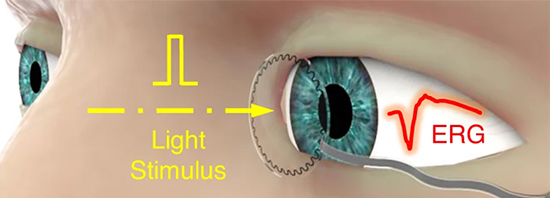The Purdue Research Foundation Office of Technology Commercialization recently secured a patent for a new contact lens technology to help diagnose and monitor ocular health conditions, as reported in ScienceDaily. Like other ‘smart’ contact lenses, biosensors embedded on the soft contact lenses record electrophysiological activity from the corneal surface. But there’s a difference. Geared for retinal activity, the ultrathin biosensors are stretchable, making them more compatible with the curved shape of commercial soft contact lenses, increasing patient comfort.
The lenses will take an electroretinogram (ERG) that measures the electrical activity of the retina in response to a light stimulus. The ERG is used for the diagnosis or early detection of many ocular diseases such as glaucoma, retinitis pigmentosa, diabetic retinopathy, retinoschisis (splitting of the retina into two layers), detachment, and other congenital degenerations. Current ERG devices use a rigid lens with an uneven surface that includes protrusions and requires topical anesthesia. Even with topical anesthesia, however, patients experience discomfort to the cornea and eyelid. In some cases, depending on their tolerance levels, patients require sedation or general anesthesia, increasing the risks of the procedure. But soon, we’ll have a better way.
 Image courtesy of www.nature.com/articles/s41467-021-21916-8 |
The broad range of applications for contact lenses beyond vision is expanding rapidly, especially as a comfortable and convenient method of medical monitoring. Contact lenses that monitor glucose levels and deliver drugs are already available. Learn more about the future of contact lenses with our CE, Therapeutic Contact Lenses and Beyond, at 2020mag.com/ce, and get ready for the future!












